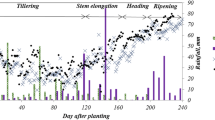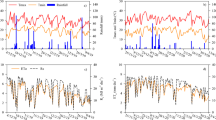Abstract
There are multiple methods being used for scheduling irrigation applications that range from weather-based to ground-based methods. Growers must choose a method that is ideally both accurate and economical to use in a production agriculture system. One method that has been used is model-based scheduling. In this study, the CROPGRO-Soybean model in the Decision Support System for Agrotechnology Transfer (DSSAT) was used to simulate the growth and development of irrigated soybean for a production soybean field throughout the 2018 and 2020 growing seasons. Model predictions were compared to soil moisture data recorded from 44 sensor sets placed across the field on a 55- × 55-m grid at depths of 31 and 61 cm. Results showed that the model accurately predicted plant height and LAI in 2018 and 2020. In both seasons, the model underpredicted soil moisture and occasionally did not respond to irrigation or rainfall. Even though the model underpredicted soil moisture, it predicted fewer irrigation events and half the cumulative amount in 2018 than the farmer applied and similar irrigation events and quantity in 2020. DSSAT predicted yield well for both years as compared to measured yields, indicating the farmer may have over-irrigated in 2018. This study advances the application of DSSAT for estimating soybean vegetative characteristics and irrigation scheduling in a production environment.











Similar content being viewed by others

References
Adhikari P, Ale S, Bordovsky JP, Thorp KR, Modala NR, Rajan N, Barnes EM (2016) Simulating future climate change impacts on seed cotton yield in the Texas High Plains using the CSM-CROPGRO-Cotton model. Agric Water Manage 164:317–330. https://doi.org/10.1016/j.agwat.2019.05.030
Ahmed M, Akram MN, Asim M, Aslam M, Hassan F, Higgins S, Stöckle CO, Hoogenboom G (2016) Calibration and validation of APSIM-Wheat and CERES-Wheat for spring wheat under rainfed conditions: models evaluation and application. Comput Electron Agric 123:384–401. https://doi.org/10.1016/j.compag.2016.03.015
Anjitha Krishna P (2018) Evaporation and agriculture—a review. Agric Rev 40:1–11. https://doi.org/10.18805/ag.R-1848
Araya A, Prasad PVV, Gowda PH, Afewerk A, Abadi B, Foster AJ (2019) Modeling irrigation and nitrogen management of what in northern Ethiopia. Agric Water Manage 216:264–272. https://doi.org/10.1016/j.agwat.2019.01.014
Cole S, Mikhailova E, Post C, Privette C, Schlautman MA, Cope M (2017) Comparing SSURGO data with geospatial field measurements to estimate soil texture and infiltration rate classes in glaciated soils. Commun Soil Sci Plant Anal 48(11):1309–1318. https://doi.org/10.1080/00103624.2017.1341916
De Jonge KC, Thorp KR (2017) Implementing standardized reference evapotranspiration and dual crop coefficient approach in the DSSAT cropping system model. Trans ASABE 60(6):1965–1981. https://doi.org/10.13031/trans.12321
Gee GW, Bauder JW (1986) Particle-size analysis. In: Klute A (ed) Methods of soil analysis, vol 1, 2nd edn. ASA CSSA, Madison, pp 383–411
Getachew F, Bayabil HK, Hoogenboom G, Teshome FT, Zewdu E (2021) Irrigation and shifting planting date as climate change adaptation strategies for sorghum. Agric Water Manage 255:106988. https://doi.org/10.1016/j.agwat.2021.106988
Guzmán SM, Paz JO, Tagert MLM, Mercer AE, Pote JW (2018) An integrated SVR and crop model to estimate the impacts of irrigation on daily groundwater levels. Agric Syst 159:248–259. https://doi.org/10.1016/j.agsy.2017.01.017
Hoogenboom G, Porter CH, Boote KJ, Shelia V, Wilkens PW, Singh U, White JW, Asseng S, Lizaso JI, Moreno LP, Pavan W, Ogoshi R, Hunt LW, Tsuji GY, Jones JW (2019a) The DSSAT crop modeling ecosystem. In: Boote KJ (ed) Advances in crop modeling for a sustainable agriculture. Burleigh Dodds Science Publishing, Cambridge, UK, pp 173–216
Hoogenboom G, Porter CH, Shelia V, White KJ, Hunt LA, Ogoshi R, Lizaso JI, Koo J, Asseng S, Singels A et al (2019b) Decision support system for agrotechnology transfer (DSSAT) version 4.7.5. DSSAT Foundation, Gainesville, FL
Installation and Operating Instructions: watermark soil moisture meter. Available online https://www.irrometer.com/pdf/instruction-manuals/sensors/701MeterManual-WEB.pdf
Irmak A, Batchelor WD, Jones IS, Paz JO, Beck H (2002) Relationship between plant available soil water and yield for explaining within-field soybean yield variability. Appl Eng Agric 18(4):471–482. https://doi.org/10.13031/2013.8748
Jabro JD, Stevens WB, Iversen WM, Allen BL, Sainju UM (2020) Irrigation scheduling based on wireless sensors output and soil-water characteristic curve in two soils. Sensors (basel). https://doi.org/10.3390/s20051336
Jiang R, Wentian H, Zhou W, Hou Y, Yang JY, He P (2019) Exploring management strategies to improve maize yield and nitrogen use efficiency in northeast China using the DNDC and DSSAT models. Comput Electron Agric 166:104988. https://doi.org/10.1016/j.compag.2019.104988
Kadiyala MDM, Jones JW, Mylavarapu RS, Li YC, Reddy MD (2015) Identifying irrigation and nitrogen best management practices for aerobic rice–maize cropping system for semi-arid tropics using CERES-rice and maize models. Agric Water Manage 149:23–32. https://doi.org/10.1016/j.agwat.2014.10.019
Kisekka I, Schlegel A, Ma L, Gowda PH, Prasad PVV (2017) Optimizing preplant irrigation for maize under limited water in the High Plains. Agric Water Manage 187:154–163. https://doi.org/10.1016/j.agwat.2017.03.023
LI-COR (2016) LAI-2200C instruction manual
Liu HL, Yang JY, Tan CS, Drury CF, Reynolds WD, Zhang TQ, Bai YL, Jin J, He P, Hoogenboom G (2011) Simulating water content, crop yield and nitrate-N loss under free and controlled tile drainage with subsurface irrigation using the DSSAT model. Agric Water Manage 98:1105–1111. https://doi.org/10.1016/j.agwat.2011.01.017
Malik W, Dechmi F (2019) DSSAT modelling for best irrigation management practices assessment under Mediterranean conditions. Agric Water Manage 216:27–43. https://doi.org/10.1016/j.agwat.2019.01.017
McClendon R, Hoogenboom G, Seginer I (1996) Optimal control and neural networks applied to peanut irrigation management. Trans ASAE 39:275–279. https://doi.org/10.13031/2013.27507
Nielsen D, Biggar J, Erh K (1973) Spatial variability of field-measured soil-water properties. Hilgardia 42:215–260. https://doi.org/10.3733/hilg.v42n07p215
Palosuo T, Kersebaum KC, Angulo C, Hlavinka P, Moriondo M, Olesen JE, Patil RH, Ruget F, Rumbaur C, Takáč J, Trnka M, Bindi M, Çaldağ B, Ewert F, Ferrise R, Mirschel W, Şaylan L, Šiška B, Rötter R (2011) Simulation of winter wheat yield and its variability in different climates of Europe: a comparison of eight crop growth models. Eur J Agron 35(3):103–114. https://doi.org/10.1016/j.eja.2011.05.001
Paz JO, Batchelor WD, Colvin TS, Logsdon SD, Kaspar TC, Karlen DL (1998) Analysis of water stress effects causing spatial yield variability in soybeans. Trans ASAE 41:1527–1534. https://doi.org/10.13031/2013.17284
Paz JO, Batchelor WD, Babcock BA, Colvin TS, Logsdon SD, Kaspar TC, Karlen DL (1999) Model-based technique to determine variable rate nitrogen for corn. Agric Syst. https://doi.org/10.1016/S0308-521X(99)00035-9
Phetheet J, Hill MC, Barron RW, Gray BJ, Wu H, Amanor-Boadu V, Heger W, Kisekka I, Golden B, Rossi MW (2021) Relating agriculture, energy, and water decisions to farm incomes and climate projections using two freeware programs, Fewcalc and DSSAT. Agric Syst 193:103222. https://doi.org/10.1016/j.agsy.2021.103222
Ritchie JT (1985) A user-orientated model of the soil water balance in wheat. In: Day W, Atkin RK (eds) Wheat growth and modelling. NATO ASI science (series A: life sciences), vol 86. Springer, Boston, MA, https://doi.org/10.1007/978-1-4899-3665-3_27
Ritchie JT (1998) Soil water balance and plant water stress. In: Tsuji GY, Hoogenboom G, Thornton PK (eds) Understanding options for agricultural production. Systems approaches for sustainable agricultural development, vol 7. Springer, Dordrecht. https://doi.org/10.1007/978-94-017-3624-4_3
Rosenzweig C, Elliott J, Deryng D, Ruane AC, Müller C, Arneth A, Boote KJ, Folberth C, Glotter M, Khabarov N, Neumann K, Piontek F, Pugh TAM, Schmid E, Stehfest E, Yang H, Jones JW (2014) Assessing agricultural risks of climate change in the 21st century in a global gridded crop model intercomparison. Proc Natl Acad Sci USA 111:3268–3273. https://doi.org/10.1073/pnas.1222463110
Seidel SJ, Palosuo T, Thorburn P, Wallach D (2018) Towards improved calibration of crop models—where are we now and where should we go? Eur J Agron 94:25–35. https://doi.org/10.1016/j.eja.2018.01.006
Seidl M, Batchelor WD, Paz JO (2004) Integrating remotely sensed images with a soybean model to improve spatial yield simulation. Trans ASAE 47:2081–2090. https://doi.org/10.13031/2013.17793
Sharda V, Gowda PH, Marek G, Kisekka I, Ray C, Adhikari P (2019) Simulating the impacts of irrigation levels on soybean production in Texas High Plains to manage diminishing groundwater levels. J Am Water Resour Assoc 55:56–69. https://doi.org/10.1111/1752-1688.12720
Siad SM, Iacobellis V, Zdruli P, Gioia A, Stavi I, Hoogenboom G (2019) A review of coupled hydrologic and crop growth models. Agric Water Manage 224:105746. https://doi.org/10.1016/j.agwat.2019.105746
Soldevilla-Martinez M, Quemada M, López-Urrea R, Muñoz-Carpena R, Lizaso JI (2014) Soil water balance: comparing two simulation models of different levels of complexity with lysimeter observations. Agric Water Manage 139:53–63. https://doi.org/10.1016/j.agwat.2014.03.011
Staff, S.S., Service, N.R.C.S., Agriculture, U.S.D.A. Soil report for Noxubee county, MS. Available https://websoilsurvey.sc.egov.usda.gov
Tagert ML, Hodges BC, Paz JO, Reginelli D (2020) Factors affecting in-field soil water variability and irrigation. In: 6th Decennial national irrigation symposium, December 2021, San Diego, California. https://doi.org/10.13031/irrig.2020-116
Tang Q, Feng G, Fisher D, Zhang H, Ouyang Y, Adeli A, Jenkins J (2017) Rain water deficit and irrigation demand of major row crops in the Mississippi Delta. Trans ASABE 61:927–935. https://doi.org/10.13031/trans.12397
Thorp KR, DeJonge KC, Kaleita AL, Batchelor WD, Paz JO (2008) Methodology for the use of DSSAT models for precision agriculture decision support. Comput Electron Agric 64:276–285. https://doi.org/10.1016/j.compag.2008.05.022
Thorp KR, Hunsaker DJ, Bronson KF, Andrade-Sanchez P, Barnes EM (2017) Cotton irrigation scheduling using a crop growth model and FAO-56 methods: field and simulation studies. Trans ASABE 60:2023–2039. https://doi.org/10.13031/trans.12323
Timsina J, Godwin D, Humphreys E, Yadvinder S, Bijay S, Kukal SS, Smith D (2008) Evaluation of options for increasing yield and water productivity of wheat in Punjab, India using the DSSAT-CSM-CERES-Wheat model. Agric Water Manage 95:1099–1110. https://doi.org/10.1016/j.agwat.2008.04.009
USDA. NRCS MLRA 135A
van Genuchten MA (1980) Closed-form equation for predicting the hydraulic conductivity of unsaturated soils. Soil Sci Soc Am J 44:892–898. https://doi.org/10.2136/sssaj1980.03615995004400050002x
Vereecken H, Huisman JA, Pachepsky Y, Montzka C, van der Kruk J, Bogena H, Weihermüller L, Herbst M, Martinez G, Vanderborght J (2014) On the spatio-temporal dynamics of soil moisture at the field scale. J Hydrol 516:76–96. https://doi.org/10.1016/j.jhydrol.2013.11.061
Willmott CJ, Ackleson SG, Davis RE, Feddema JJ, Klink KM, Legates DR, O’Donnell J, Rowe CM (1985) Statistics for the evaluation of model performance. J Geophys Res 90:8995–9005. https://doi.org/10.1029/JC090iC05p08995
Yang JM, Yang JY, Liu S, Hoogenboom G (2014) An evaluation of the statistical methods for testing the performance of crop models with observed data. Agric Syst 127:81–89. https://doi.org/10.1016/j.agsy.2014.01.008
Acknowledgements
We thank the Mississippi Soybean Promotion Board and the Southern Region USDA-SARE Graduate Student Grant for providing the funds to conduct this research. We also appreciate the help of student workers Jessica Simmerman and Christain Porterfield and graduate students Meredith Brock and Will Monroe for the field work assistance they provided. We are grateful that Mr. Dale Weaver and Mr. Paul Good allowed this research to be conducted on their farm.
Funding
The study was funded by the Mississippi Soybean Promotion Board and a USDA-Southern SARE Graduate Student Grant.
Author information
Authors and Affiliations
Corresponding author
Ethics declarations
Conflict of interest
On behalf of all authors, the corresponding author states that there is no conflict of interest.
Additional information
Publisher's Note
Springer Nature remains neutral with regard to jurisdictional claims in published maps and institutional affiliations.
Rights and permissions
About this article
Cite this article
Hodges, B., Tagert, M.L. & Paz, J.O. Use of a crop model and soil moisture sensors for estimating soil moisture and irrigation applications in a production soybean field. Irrig Sci 40, 925–939 (2022). https://doi.org/10.1007/s00271-022-00802-1
Received:
Accepted:
Published:
Issue Date:
DOI: https://doi.org/10.1007/s00271-022-00802-1



